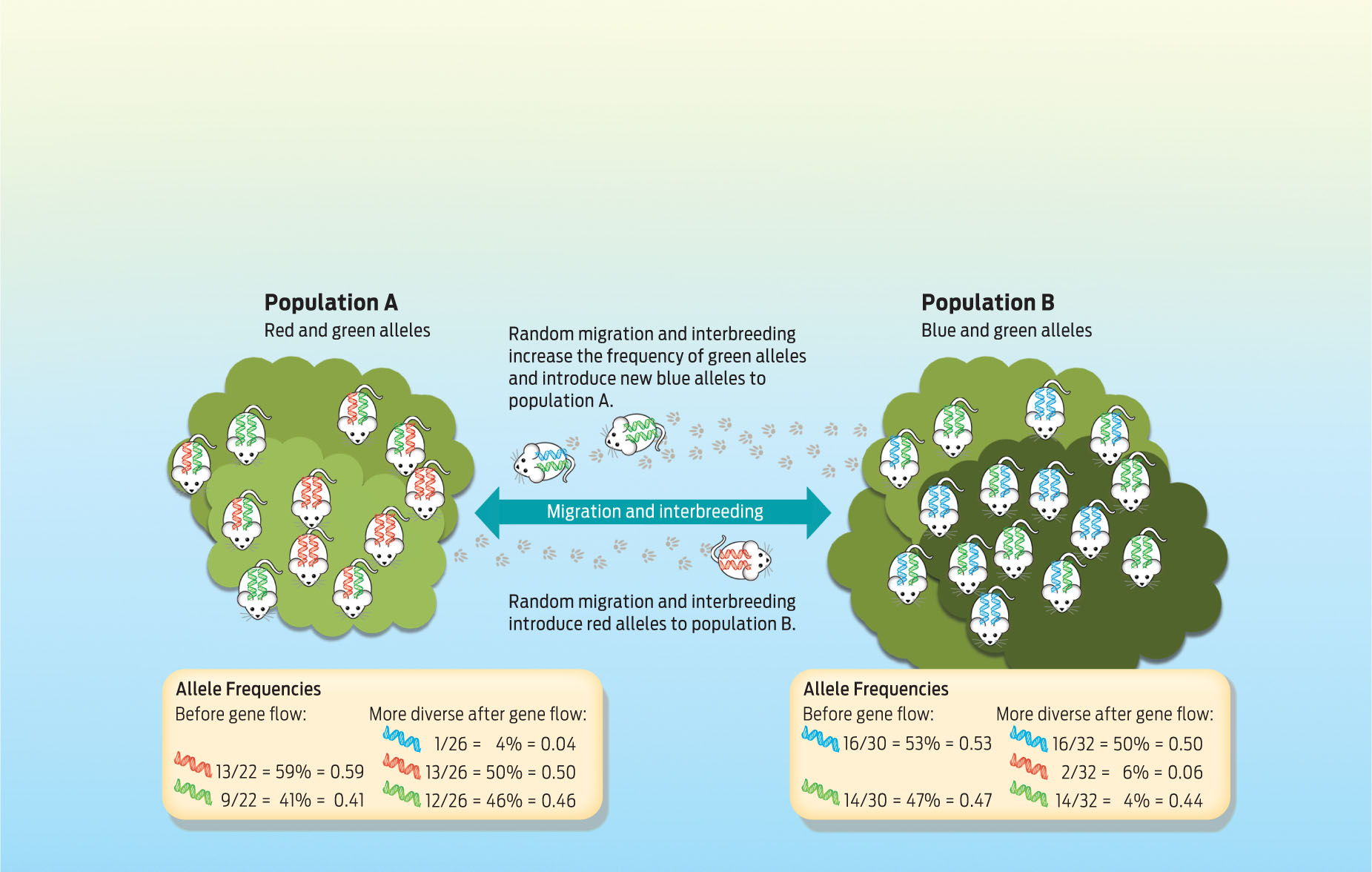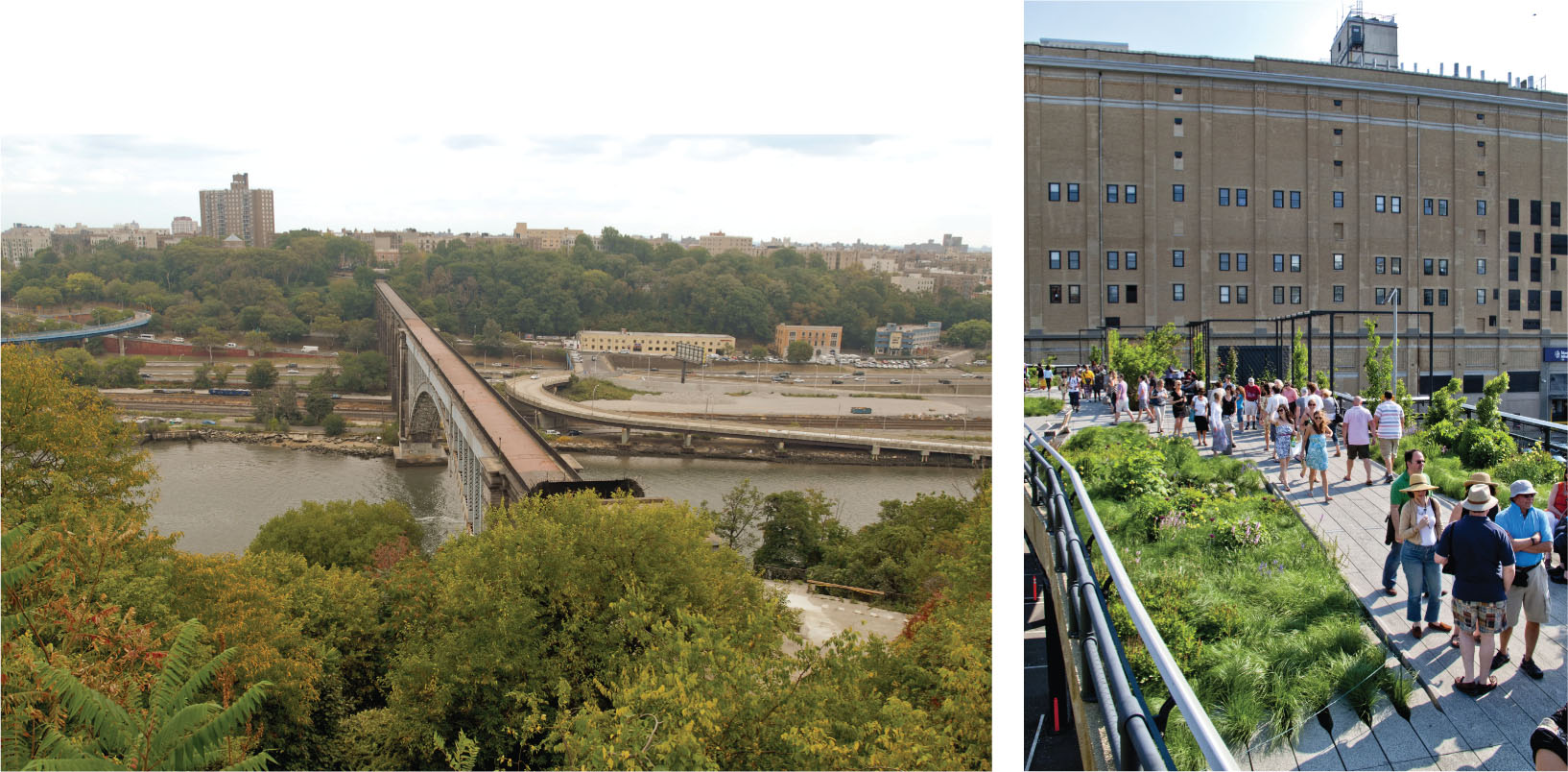THE DAILY COMMUTE: GENE FLOW
GENE FLOW The movement of alleles from one population to another, which may increase the genetic diversity of a population.
Once a population has lost genetic diversity because of genetic drift, there are only two ways that genetic diversity can be reintroduced: (1) by mutation, which as we saw in Chapter 10 continually introduces new alleles into the population, and (2) by gene flow, in which alleles move between populations. Like genetic drift, gene flow is a type of nonadaptive evolution that does not lead to a population becoming more adapted to its environment. Unlike genetic drift, gene flow tends to increase the genetic diversity of a population (INFOGRAPHIC 15.4).
Migration and interbreeding of individuals move alleles between populations. Populations that can interbreed with other populations have higher allele diversity than isolated populations.

Munshi-South and his colleagues found that different New York City mice populations had different levels of gene flow, meaning that some populations exchanged alleles with other populations more than others. They wanted to understand why, so they built a statistical model and tested whether it could explain the data they collected at their study sites. Their idea was this: gene flow should be possible between populations where there is a corridor of tree canopy connecting them. So they divided the city into categories based on the percentage of “green” landscape (tree cover) or “gray” landscape (concrete), and then tested how closely their actual data matched the hypothetical results. It was a simple idea, but it worked surprisingly well. “That pretty much explained the variation we saw in gene flow and drift between the populations,” he says. In fact, the “green corridor” model explained the amount of gene flow even more than the absolute distance between the populations.
INBREEDING Mating between closely related individuals. Inbreeding does not change the allele frequency within a population, but it does increase the proportion of homozygous individuals to heterozygotes.
Putting it all together, the picture looks like this: urbanization has led to habitat fragmentation that has isolated and bottlenecked dozens of mice populations, leaving each with a distinct gene pool. Populations that were completely isolated (e.g., sites 10 and 12 in Infographic 15.2) have continued to diverge by genetic drift, while populations connected to other populations by a green corridor (e.g., sites 8, 9, and 11 in Infographic 15.2) have remained more similar to one another because of gene flow between them. Furthermore, mutation randomly adds new alleles to these populations, contributing to diversity between them. “So it’s basically this interplay between genetic drift, gene flow, and mutation,” says Munshi-South, that is influencing the level of genetic diversity in the populations.
INBREEDING DEPRESSION The negative reproductive consequences for a population associated with having a high frequency of homozygous individuals possessing harmful recessive alleles.
One reason gene flow is important is that small, isolated populations can be damaged by lack of genetic diversity. Take the Florida panther (Puma concolor), for example. In the past, Florida panthers mated with puma populations from neighboring states where their ranges overlapped. This interbreeding—breeding among populations—fostered an exchange of alleles that continually enriched the local populations’ genetic diversity. By the mid-20th century, however, hunting and development had squeezed the Florida panther population into an isolated region at the state’s southernmost tip. By 1967, only 30 panthers remained, and the U.S. Fish and Wildlife Service listed them as endangered. By 1980, the panthers showed unmistakable signs of ill health—birth defects, low sperm count, missing testes, and bent tails—that resulted from inbreeding, mating between closely related members of a population.
Inbreeding can have dangerous consequences for a population. Because closely related individuals are more likely to share the same alleles, the chance of two recessive harmful alleles coming together during mating is high. When that happens, homozygous recessive genotypes are created, and previously hidden recessive alleles start to affect phenotypes in negative ways. This effect is called inbreeding depression.
To counteract this dangerous trend, the U.S. Fish and Wildlife Service, in 1995, brought in eight female pumas from Texas to mate with Florida’s male panthers and thereby introduce genetic diversity. The program was successful: the hybrid kittens—30 in all—showed no signs of inbreeding depression. By 2007, more than 100 healthy panthers were roaming the swamps and grasslands of Florida.
For the time being, says Munshi-South, mice in Manhattan seem to be doing just fine in maintaining adequate genetic diversity. While the populations are clearly distinct from one another, each also has within it a fair amount of genetic diversity. This is probably because each population is still quite large and so the drift that is occurring has not dramatically reduced the number of alleles in each population. That fact, combined with mutation and occasional episodes of gene flow between some of the populations, has allowed these populations to maintain significant genetic diversity.
The same cannot be said of other species that Munshi-South and his colleagues are studying in New York City. The northern dusky salamander (Desmognathus fuscus), which makes its home in freshwater streams seeping out of the ground, was once extremely common throughout much of the city just 60 years ago. Today, it clings to a single hillside in northern Manhattan and to parts of Staten Island—a severe bottleneck. Not only that, but this single hillside has been bisected not once, but twice, by bridges connecting the boroughs of the Bronx and Manhattan, thus dividing this small, isolated population even further. Munshi-South and his colleagues have found that the populations living on either side of these bridges are genetically distinct—evidence that significant gene flow is not happening between them. Whether or not the dusky salamanders will be able to retain their tenuous hold along this hillside, only time will tell.
